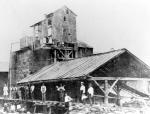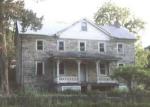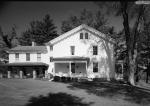![header=[Marker Text] body=[Along the streams of this region are ruins of many charcoal iron furnaces and forges built between 1790-1850. Juniata iron was the best in America. Its reign ended with the rise of coal and coke iron making.] sign](http://explorepahistory.com/kora/files/1/10/1-A-2A8-139-ExplorePAHistory-a0k1s8-a_450.jpg)
Mouse over for marker text
Name:
Juniata Iron
Region:
Laurel Highlands/Southern Alleghenies
County:
Huntingdon
Marker Location:
U.S. 22 just E of Water Street
Dedication Date:
April 29, 1947
Behind the Marker
The Juniata iron industry began in 1785 when Bedford Furnace went into blast. George Ashman and Company erected this furnace in present-day Orbisonia, making it the first furnace west of the Susquehanna River valley. Bedford Furnace produced pig iron, stove plates and utensils. The success of early ironworks such as Bedford Furnace, deposits of iron ore, plentiful forests that provided charcoal for fuel, and numerous streams for water power attracted other ironmasters to present-day Centre, Huntingdon, Juniata and Mifflin counties that comprised the Juniata iron region. A growing population in the area and resultant demand for iron products also spurred the rise of the iron industry. By the 1830s this region became one of Pennsylvania's most important iron manufacturing areas.
Iron making took off in the Juniata iron region during the 1790s. About seventeen furnaces and forges joined Bedford Furnace, including Centre Furnace, which went into blast in 1792. Ironmasters found markets in the local area as well as in distant Pittsburgh, which was becoming a gateway to the Ohio River and the west. Bar iron, slit iron and nails went by mules on mountain paths to Pittsburgh. Economic stability during the 1790s also favored the growth of the iron industry in this region, as well as in other areas of Pennsylvania.
Centre Furnace, which went into blast in 1792. Ironmasters found markets in the local area as well as in distant Pittsburgh, which was becoming a gateway to the Ohio River and the west. Bar iron, slit iron and nails went by mules on mountain paths to Pittsburgh. Economic stability during the 1790s also favored the growth of the iron industry in this region, as well as in other areas of Pennsylvania.
The iron industry continued to grow in the Juniata iron region through the 1830s as local population and demand expanded. Ironmasters also continued sending iron to Pittsburgh, where lack of foreign competition so far inland kept domestic iron prices higher than in coastal areas. Ironmasters shipped iron down the Juniata and Susquehanna rivers to Baltimore and wider markets beyond. With the coming of the Pennsylvania canal in the mid-1830s, they had another transportation route connecting their ironworks to larger markets. In 1850 a total of fifty-five ironworks operated in the Juniata region, including Eagle Ironworks,
Eagle Ironworks,  Coleraine Forges and
Coleraine Forges and  Greenwood Furnace. These were all charcoal furnaces and forges.
Greenwood Furnace. These were all charcoal furnaces and forges.
Industrial growth in the Juniata iron region was not always steady, and some ironmasters failed. David R. Porter for example, invested in forges that went under in 1819 in the wake of the Panic of 1817. Subsequently, the Panic of 1837 depressed the iron industry in this region and throughout Pennsylvania. But many ironworks continued through 1850, and a few survived exceptionally long, most notably Eagle Ironworks, which was the last to close in 1922. Nevertheless, by the mid-nineteenth century, anthracite-coal furnaces, located to the east, were eclipsing charcoal furnaces in the Juniata iron region in terms of output, cost and profitability. Similarly, bituminous-coke furnaces to the west began to make inroads into the production of charcoal furnaces. By mid-century the Juniata iron region was falling behind other areas in the Commonwealth.
David R. Porter for example, invested in forges that went under in 1819 in the wake of the Panic of 1817. Subsequently, the Panic of 1837 depressed the iron industry in this region and throughout Pennsylvania. But many ironworks continued through 1850, and a few survived exceptionally long, most notably Eagle Ironworks, which was the last to close in 1922. Nevertheless, by the mid-nineteenth century, anthracite-coal furnaces, located to the east, were eclipsing charcoal furnaces in the Juniata iron region in terms of output, cost and profitability. Similarly, bituminous-coke furnaces to the west began to make inroads into the production of charcoal furnaces. By mid-century the Juniata iron region was falling behind other areas in the Commonwealth.
Iron making took off in the Juniata iron region during the 1790s. About seventeen furnaces and forges joined Bedford Furnace, including
The iron industry continued to grow in the Juniata iron region through the 1830s as local population and demand expanded. Ironmasters also continued sending iron to Pittsburgh, where lack of foreign competition so far inland kept domestic iron prices higher than in coastal areas. Ironmasters shipped iron down the Juniata and Susquehanna rivers to Baltimore and wider markets beyond. With the coming of the Pennsylvania canal in the mid-1830s, they had another transportation route connecting their ironworks to larger markets. In 1850 a total of fifty-five ironworks operated in the Juniata region, including
Industrial growth in the Juniata iron region was not always steady, and some ironmasters failed.
Beyond the Marker








